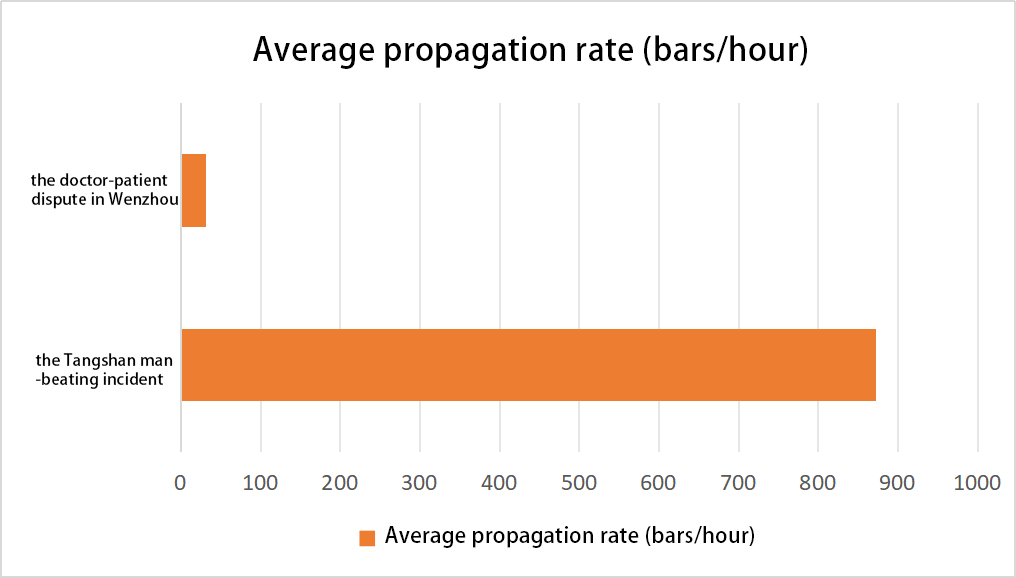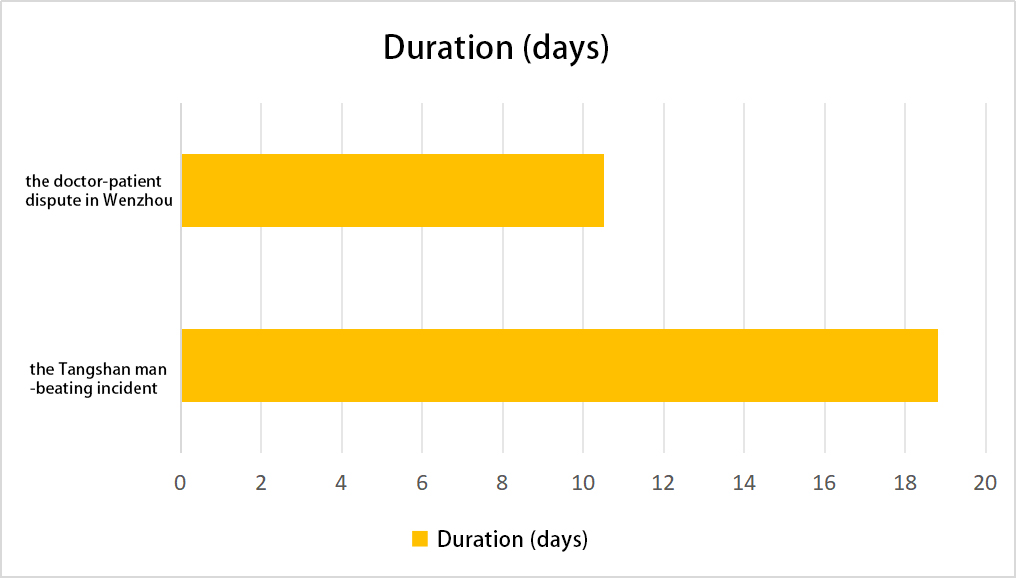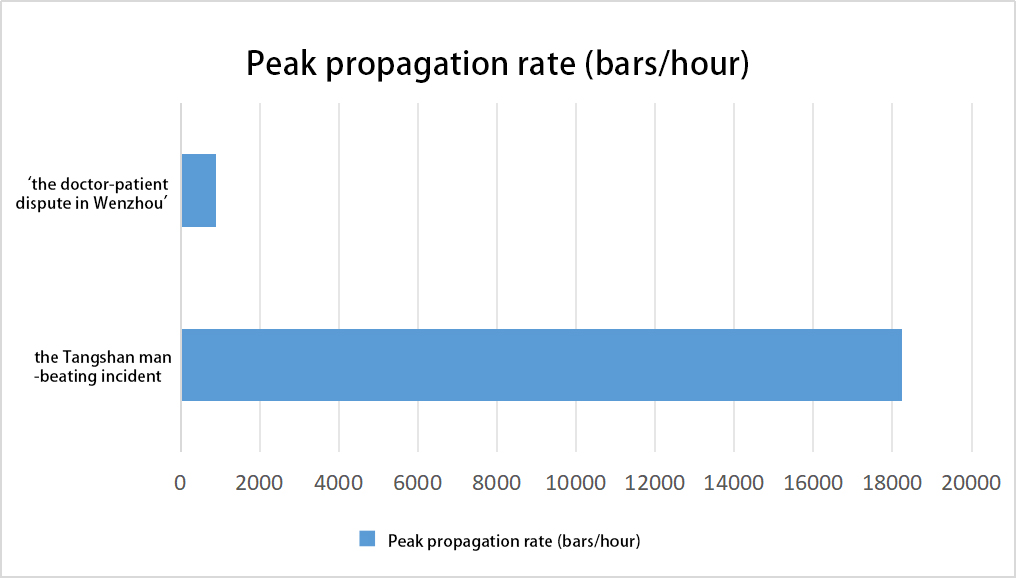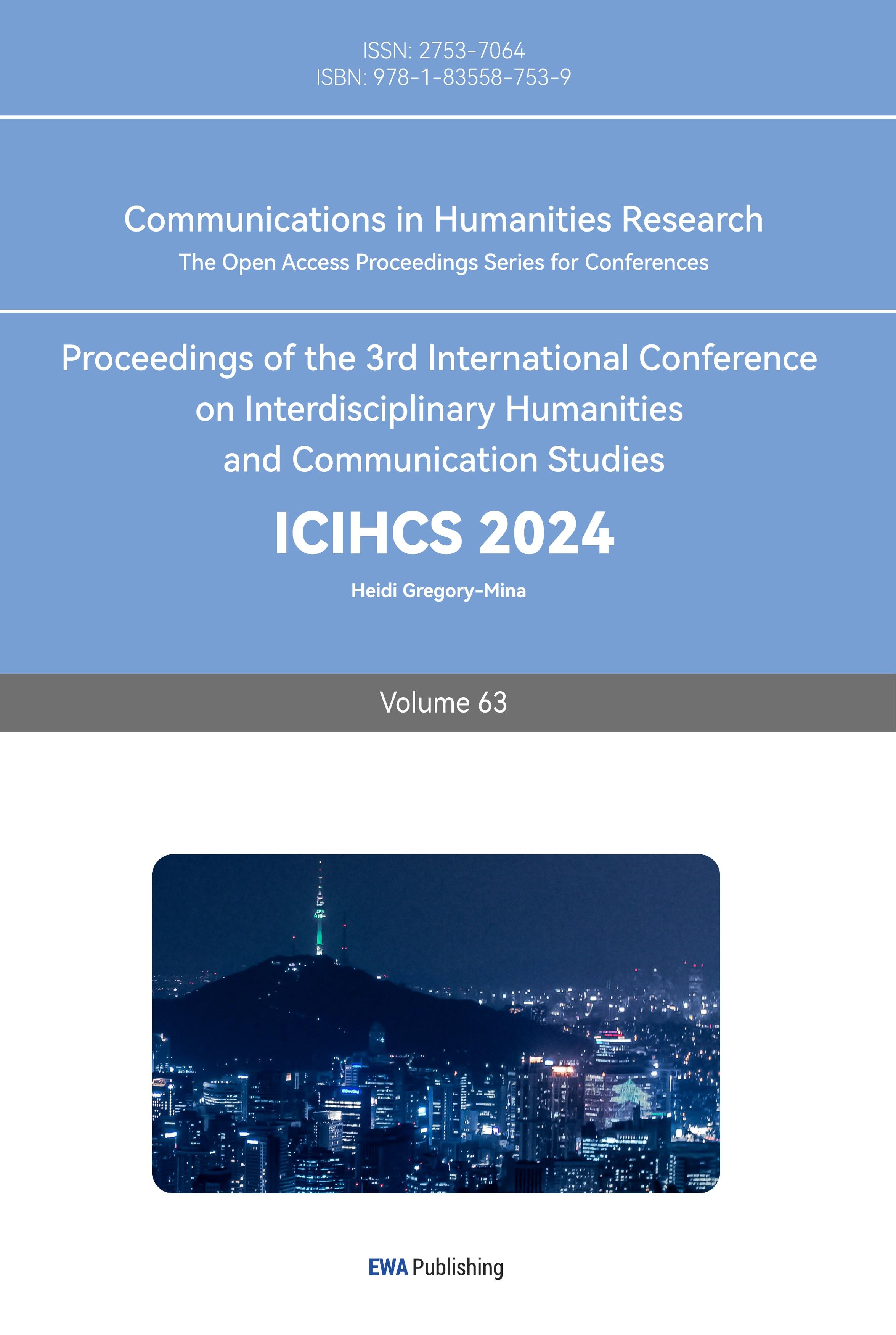1. Introduction
1.1. Research Background and Themes
In recent years, with the popularity of social media and the accelerated speed of information dissemination, social media platforms have played an important role in the dissemination of public emergencies. In the era of information explosion, public opinion triggered by emergencies not only affects the public's perceptions and emotions, but also has far-reaching impacts on the handling of the incidents and social stability. Among the many public opinion incidents, medical violence, especially vicious injuries to healthcare workers, usually triggers strong reactions and extensive discussions in the society because they are directly related to public health and life safety. The medical violence incident represented by ‘the doctor-patient dispute in Wenzhou, China on 7.19’ fully embodies the characteristics of the spread of emergencies on social media and the complex emotional reactions it triggers.
‘The doctor-patient dispute in Wenzhou’ occurred on 19 July 2024, a man with a knife attacked Dr. Li Sheng of the First Hospital of Wenzhou Medical University, resulting in the unfortunate death of Dr. Li, after the incident, the incident quickly attracted widespread attention and discussion on social media, and the heat of related topics continued to climb. By analysing the communication path and user sentiment changes of this incident, we can better understand the communication mechanism of public emergencies in social media and provide theoretical support for responding to and guiding public opinion.
1.2. Purpose and Significance of the Research
The main purpose of this study is to explore the communication path, communication speed, and the change and influence of users' emotion of ‘the doctor-patient dispute in Wenzhou, China on 7.19’ in social media, and to analyse the communication characteristics of this specific event, so as to reveal the communication mode of public emergency events and its influence on the society under the environment of social media, with the significance of providing effective public opinion monitoring and response strategies for the relevant departments when facing emergencies in the future. The significance of this study is that it can provide effective public opinion monitoring and response strategies for relevant departments when facing emergencies in the future, and it is also expected to provide empirical support for academic research in the field of public opinion event communication and user sentiment analysis.
In recent years, medical violence has been occurring frequently, bringing about great social impact and public opinion repercussions. Compared with other emergencies, medical violence spreads faster and the emotional fluctuations are more intense. By studying the difference in communication between ‘the doctor-patient dispute in Wenzhou, China on 7.19’ and other emergencies, we can have a clearer understanding of the communication pattern and emotional evolution characteristics of these incidents on social media; this study also tries to further explore the relationship between users' emotions and their willingness to disseminate information by using big data analysis and emotion recognition technology, providing new insights for future public opinion research. This study also tries to further explore the relationship between users' emotions and their willingness to disseminate information through big data analysis and emotion recognition technology, which will provide new perspectives and methods for future opinion research.
1.3. Research Methodology
This study adopts a combination of quantitative and qualitative research methods. In quantitative research, we mainly rely on data collection and statistical tools to analyse the speed of dissemination of the event, the path of dissemination, and the changes in users' emotions. In terms of qualitative research, we analysed user comments and public opinion trends on social media to reveal changes in public sentiment and their reactions to the incident; we also adopted a comparative analysis method, comparing ‘the doctor-patient dispute in Wenzhou’ with the ‘Tangshan Man-Punching Incident’, in terms of the speed of dissemination. The study also adopted a comparative analysis method, using ‘the doctor-patient dispute in Wenzhou’ and ‘the Tangshan man-beating incident’ as comparisons, analysing the speed of dissemination, duration and emotional changes.
1.4. Framework of the Research in the Following Section
The structure of this paper is divided into six parts. The first part is the introduction of the study, outlining the background, purpose, significance and methodology of the study. The second part is the literature review, which reviews the communication characteristics of medical violence and public emergencies in China in recent years, and explores the concept and practical application of user emotion. The third part is the research methodology, which describes in detail the design, data collection, analysis tools and methods of the study. The fourth part is the research results, which shows the results of the data analysis, including the communication path, speed and changes in user emotions, etc. The fifth part is the research discussion, which explores the significance of the results of the study and its implications for future research, and the sixth part is the conclusion, which reviews the study, reflects on the limitations of the study and looks forward to the future direction of the study.
2. Literature Review
2.1. Overview of Medical Disputes in China
Medical malpractice, as an extreme form of doctor-patient dispute, has become commonplace in China in recent years. It refers to the behaviour of patients employed on the patient side of a medical dispute who, together with their family members, take various routes to put pressure on and profit from the hospital in the form of seriously obstructing the medical order, expanding the situation, and causing a negative impact on the hospital. Such incidents are often accompanied by violent injuries, which seriously threaten the life safety and working environment of healthcare workers, and cause adverse social impacts. From 2016 to 2024, multiple medical disputes occurred one after another across the country, attracting widespread social attention and media coverage. In October 2016, Li Baohua, a paediatrician at Laigang Hospital in Shandong Province, was hacked and injured by a patient's family member with 27 stab wounds, and unfortunately passed away In December 2019, Yang Wen, deputy chief physician of the emergency department of the Civil Aviation General Hospital in Chaoyang District, Beijing, was viciously injured by a patient's family member during his work, resulting in serious neck injuries and died after failing to be rescued. In January 2020, Tao Yong, chief ophthalmologist of Chaoyang Hospital in Beijing, was attacked by a patient with a knife during his outpatient clinic visit, resulting in a fracture of the left hand, a break of neuromuscular blood vessels, and cranio-cerebral trauma, among other serious injuries.
The frequent occurrence of these medical incidents has not only triggered extensive social discussions on the doctor-patient relationship, but also revealed deep-rooted problems such as the uneven distribution of medical resources and difficulties in accessing medical care, the media and public response to these incidents showed a highly consistent condemnation attitude, and at the same time called on the relevant departments to strengthen the crackdown on the violent injury of doctors and to protect the safety of medical workers, compared with other types of emergencies, medical incidents have a Compared with other types of emergencies, medical malpractice incidents spread faster and public opinion reacted more strongly. This phenomenon is related to the fact that the direct victims of medical malpractice incidents are healthcare workers, which leads to a more directional and professional discussion of the incidents.
2.2. Overview of ‘The Doctor-Patient Dispute in Wenzhou, China On 7.19’
July 19, 2024, Wenzhou Medical University Affiliated Hospital No. 1 occurred a serious violent injury to doctors, because of his family members in the hospital after surgery recovery is not ideal, the perpetrator with a knife broke into the clinic, cardiovascular internal medicine doctor Li Sheng implementation of indiscriminate injuries, resulting in multiple serious injuries, and ultimately failed to save the death of Dr. Li. Perpetrator then jumped to his death, after the incident, Wenzhou Municipal Public Security Bureau Ouhai District Branch through the microblogging police bulletin, the media have reported, the relevant topics quickly on the major social media platforms hot search list. The wide dissemination of the incident and the public's strong reaction reflected the society's high concern and deep-rooted worries about doctor-patient conflicts [1].
The dissemination path of the Wenzhou doctor incident is similar to other emergencies, with typical characteristics of online public opinion dissemination. At the early stage of the incident, the information spread rapidly through social media, and the emotional comments of the media and individual users further promoted the dissemination of the incident, and at around 10:00 a.m. on July 20, public opinion on the death of the doctor, the motives for the murder, the doctor's reputation, and conflicts between the doctor and the patient triggered over 4,500 comments. 4,500 articles. With the development of the incident and disclosure of more information, the heat of public opinion gradually reached its peak, and then gradually declined under the guidance of the intervention of relevant departments and information release. The whole process shows an evolution from emotional arousal to information demand to emotional attribution.
2.3. Concepts and Practical Applications of Sentiment Analysis
‘Sentiment analysis refers to analysing the emotional state implied by the speaker in conveying a message, and judging or evaluating the speaker's attitude or opinion [2].’ In recent years, with the development of deep learning and big data technologies, sentiment analysis techniques based on models such as sentiment lexicons, convolutional neural networks (CNNs), long short-term memory networks (LSTMs), and BERTs have been widely used [3].
In the analysis of public opinion on public emergencies, users' emotions are usually expressed as negative emotions such as anger, sadness, fear, etc. The higher the intensity of emotions, the faster the willingness and speed of information dissemination. Users' emotional responses to events are not only influenced by the events themselves, but also related to personal experience, social background and other factors. For example, in ‘the doctor-patient dispute in Wenzhou’, the public's emotion gradually changed from initial grief and regret to anger at the violent behaviour and concern for the safety of healthcare workers. This emotional evolution process reflects users' deeper perception of the incident and changes in their attitudes, and also provides a new perspective for understanding the evolution of public opinion.
3. Research Methodology
3.1. Research Design
This study adopts a mixed research methodology, combining comparative analysis and data collection and statistics to analyse the dissemination path, speed and emotional changes of ‘the doctor-patient dispute in Wenzhou’ on social media. The study firstly compares and analyses the dissemination speed, duration, interaction volume and emotional changes of the Wenzhou man injured doctor incident and ‘the Tangshan man-beating incident’, in order to reveal the dissemination characteristics of different types of emergencies on social media. Secondly, through data collection and statistics, the dissemination trend and users' emotional tendency of ‘the doctor-patient dispute in Wenzhou’ on the microblogging platform were analysed. Through comparative analyses and data statistics, this study aims to reveal the communication patterns of public emergencies on social media and the characteristics of users' emotional changes, so as to provide theoretical support and practical references for effective public opinion monitoring and management, as well as to provide reference for the development of more scientific and effective response strategies for similar public opinion events in the future.
3.2. Data Collection and Statistics
The scope of data collection covered some of the posts related to ‘the doctor-patient dispute in Wenzhou, China on 7.19’ on Weibo between 13:00 on 19th July and 20:00 on 22nd July 2024, and the top 20 posts under the Hot Topics were selected according to the number of likes. The study selected the top 20 posts under the hot topics according to the order of the number of likes, and conducted keyword collection and sentiment statistics. In addition, the study monitored the number of times and duration of relevant topics on the hot search list of 10 platforms, including Weibo, Shutterstock, Baidu, Shake, Zhihu, and Today's Headlines.
The collected data was preprocessed, text analysed and sentiment classified through big data analytics tools. Emotional tendencies and intensity of emotions in the text were identified to reveal users' emotional responses to events and their changes over time [4].
3.3. Data Analysis and Tools
In order to analyse the dissemination of ‘the doctor-patient dispute in Wenzhou’ on social media and the changes in user sentiment, this study used several data processing and analysis tools with the aim of making the data clearer and more understandable. The study used a big data processing tool to prepare the data, which can assist in organising the data, including removing repetitive information, cleaning up some irrelevant data (e.g., incomplete posts), and organising the content into a standard format. The content of the comments is then analysed using a method called a ‘sentiment lexicon’. This method will classify the words in the comments according to the type of emotion, such as ‘anger’, ‘sadness’, ‘support’, etc., to see what is the main emotion expressed in each comment. The results are then analysed by a visualisation tool to see the main emotions expressed in each comment. Finally, the result is made into a chart through the visualisation tool. Through the charts, you can see the spread of the event in different periods of time and the change of user sentiment very intuitively.
4. Research Results
Through data analysis, the study found that the dissemination of ‘the doctor-patient dispute in Wenzhou’ on social media showed obvious time node characteristics, and after the incident occurred, social media users reacted quickly, resulting in the incident becoming a public opinion hotspot in a short period of time. The initial dissemination of the incident reached a peak at around 13:00 on July 19, and the public opinion continued to heat up after the Public Security Bureau issued a police report at 16:00 on the same day, and reached the peak of the discussion at around 10:00 on July 20, and the volume of the public opinion gradually fluctuated and became stable with the disclosure of more official information and the holding of the memorial service.
Compared with ‘the Tangshan man-beating incident’, ‘the doctor-patient dispute in Wenzhou’ spread relatively slowly and lasted for a shorter period of time. The data showed that the average spread rate of ‘the Tangshan man-beating incident’ was 873 articles/hour, with a peak spread rate of 18,245 articles/hour, and a duration of 18 days and 20 hours, while the average spread rate of ‘the doctor-patient dispute in Wenzhou’ was 31 articles/hour, with a peak spread rate of 886 articles/hour, and a duration of 10 days and 11 hours. The duration was 10 days and 11 hours. The results of the study show that the posts in ‘the Tangshan man-beating incident’ were more emotional, with a higher retweet rate and higher amount of discussion than ‘the doctor-patient dispute in Wenzhou’.

Figure 1: Average speed of propagation.

Figure 2: Duration.

Figure 3: Peak propagation rate.
In addition, the analysis of high-frequency words shows that the keywords in the post of ‘the doctor-patient dispute in Wenzhou’ are mostly focused on medical-related words such as ‘doctor’, ‘Li Sheng’, ‘rescue’, etc., while the high-frequency words of Tangshan's beating incident are mostly ‘Tangshan’, ‘incident’, ‘girl’, etc., showing a more emotional and social character. The high-frequency words in ‘the Tangshan man-beating incident’ are mostly ‘Tangshan’, ‘incident’, ‘girl’, etc., showing more emotional and social characteristics. This difference reflects the different audience characteristics and communication mechanisms of the incidents, and further illustrates the differences in the performance of social media in the communication of different types of incidents (Figure 1, Figure 2 and Figure 3).
5. Research Discussions
Through comparative analysis, this study found that there are significant differences between ‘the doctor-patient dispute in Wenzhou’ and ‘the Tangshan man-beating incident’ in terms of the speed of dissemination, duration and users' emotional response. The victims of ‘the doctor-patient dispute in Wenzhou’ were a specific group (doctors), which was directional; while the victims of ‘the Tangshan man-beating incident’ were ordinary women, and the non-differentiated and random nature of the incident led to a wider range of dissemination and a longer duration. The audience of the Wenzhou incident was mainly groups related to doctor-patient conflicts and the safety of medical staff, while the Tangshan incident touched a wider range of social groups and social issues, which is an important reason for the difference in dissemination between the two [5].
The change of users‘ emotion also shows obvious stage, in the early stage of ‘the doctor-patient dispute in Wenzhou’, users’ emotion mainly focuses on grief and regret, with the passage of time, the anger gradually rises, users' condemnation of violent behaviour and solidarity with medical personnel become the mainstream, and this process of emotion changing from grief to anger reflects the public's simple sense of justice for illegal and corrupt events and the strong fairness and justice expectation [6].
6. Conclusion
This paper reveals the communication patterns and characteristics of public emergencies in social media by analysing the communication paths, speed of dissemination and changes in users' emotions of ‘the doctor-patient dispute in Wenzhou’. It is found that the expression of emotions in social media is closely related to the dissemination of information, and the higher the intensity of emotions, the greater the speed and breadth of information dissemination. Comparative analyses with ‘the Tangshan man-beating incident’ show that there are obvious differences in the communication characteristics of different types of emergencies and changes in users' emotions.
The limitations of this study are mainly reflected in the limitations of data and the accuracy of sentiment analysis. As the data source mainly relies on social media platforms and fails to comprehensively cover all the responses at the media and social levels, the sentiment analysis model may have some bias in dealing with complex semantics and emotional expressions, which also affects the comprehensiveness and accuracy of the results of the study.
Future research can further expand the data sources, including traditional media and other new media platforms, to comprehensively analyse the communication mechanism of emergencies; at the same time, it can combine multimodal data (e.g., images and videos) to conduct more in-depth sentiment analysis, and explore the multidimensional relationship between sentiment expression and event communication. Through continuous improvement of sentiment analysis techniques and public opinion monitoring methods, more scientific and effective support can be provided for social governance and public opinion management.
References
[1]. Gu Ming orn. (2022). A study on public opinion evolution and game of public emergencies driven by social media user data (Doctoral dissertation, China University of Geosciences). Ph.
[2]. Xi, H. X., Jiang, H. F., Cheng, Z. F. & He, S. (2020). Sentiment Analysis and Visualisation of Online Public Opinion under Specific Events. Intelligence Theory and Practice (09), 132-136+143. doi: 10.16353/j.cnki.1000-7490.2020.09.019.
[3]. Tang, Xuemei & Lai, Shengqiang. (2018). A study on the impact of emotional information on the dissemination of public opinion events. Journal of Intelligence (12), 124-129.
[4]. An Lu & Wu Lin. (2017). Evolutionary analysis of microblog public opinion on emergencies integrating thematic and emotional features. Library and Intelligence Work (15), 120-129. doi:10.13266/j.issn.0252-3116.2017.15.014.
[5]. Ji, Xuemei. (2014). Research on emotion mining and communication of Chinese microblog users under specific event context (Doctoral dissertation, Nankai University). PhD.
[6]. Zhou, Shengchen, Qu, Wenting, Yizi, Shi, Xunzhi & Sun, Yunchen. (2013). A Review of Chinese Microblog Sentiment Analysis Research. Computer Applications and Software (03), 161-164+181.
Cite this article
Zheng,J. (2024). Communication Mechanism and User Sentiment Analysis of Public Emergencies on Social Media: A Case Study of the Wenzhou Doctor-Patient Dispute on July 19. Communications in Humanities Research,63,14-21.
Data availability
The datasets used and/or analyzed during the current study will be available from the authors upon reasonable request.
Disclaimer/Publisher's Note
The statements, opinions and data contained in all publications are solely those of the individual author(s) and contributor(s) and not of EWA Publishing and/or the editor(s). EWA Publishing and/or the editor(s) disclaim responsibility for any injury to people or property resulting from any ideas, methods, instructions or products referred to in the content.
About volume
Volume title: Proceedings of 3rd International Conference on Interdisciplinary Humanities and Communication Studies
© 2024 by the author(s). Licensee EWA Publishing, Oxford, UK. This article is an open access article distributed under the terms and
conditions of the Creative Commons Attribution (CC BY) license. Authors who
publish this series agree to the following terms:
1. Authors retain copyright and grant the series right of first publication with the work simultaneously licensed under a Creative Commons
Attribution License that allows others to share the work with an acknowledgment of the work's authorship and initial publication in this
series.
2. Authors are able to enter into separate, additional contractual arrangements for the non-exclusive distribution of the series's published
version of the work (e.g., post it to an institutional repository or publish it in a book), with an acknowledgment of its initial
publication in this series.
3. Authors are permitted and encouraged to post their work online (e.g., in institutional repositories or on their website) prior to and
during the submission process, as it can lead to productive exchanges, as well as earlier and greater citation of published work (See
Open access policy for details).
References
[1]. Gu Ming orn. (2022). A study on public opinion evolution and game of public emergencies driven by social media user data (Doctoral dissertation, China University of Geosciences). Ph.
[2]. Xi, H. X., Jiang, H. F., Cheng, Z. F. & He, S. (2020). Sentiment Analysis and Visualisation of Online Public Opinion under Specific Events. Intelligence Theory and Practice (09), 132-136+143. doi: 10.16353/j.cnki.1000-7490.2020.09.019.
[3]. Tang, Xuemei & Lai, Shengqiang. (2018). A study on the impact of emotional information on the dissemination of public opinion events. Journal of Intelligence (12), 124-129.
[4]. An Lu & Wu Lin. (2017). Evolutionary analysis of microblog public opinion on emergencies integrating thematic and emotional features. Library and Intelligence Work (15), 120-129. doi:10.13266/j.issn.0252-3116.2017.15.014.
[5]. Ji, Xuemei. (2014). Research on emotion mining and communication of Chinese microblog users under specific event context (Doctoral dissertation, Nankai University). PhD.
[6]. Zhou, Shengchen, Qu, Wenting, Yizi, Shi, Xunzhi & Sun, Yunchen. (2013). A Review of Chinese Microblog Sentiment Analysis Research. Computer Applications and Software (03), 161-164+181.









